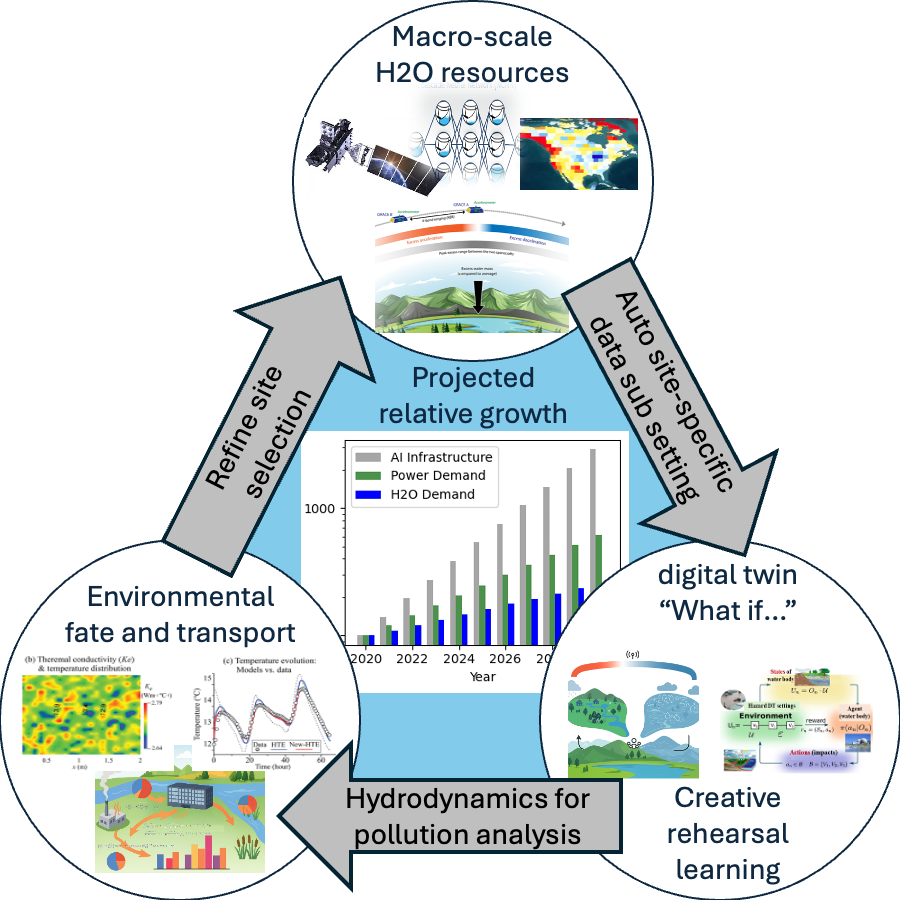Water resources analysis for expanding AI Infrastructure
The United States is committed to rapidly expanding AI Infrastructure throughout the country. This infrastructure is relient on water for cooling. We are currently analyzing the water demands and ramifications of this expanding infrastructure. Our goal is to provide guidance on where and how AI infrastructure can be build with minimal environmental impacts, and without stressing water resources. Our analysis includes novel machine learning methods, specifically designed for large-scale hydrological applications.

Funded by the National Science Foundation.
Deep Learning and PIML Integration into the National Water Model
Our current funding focuses on integrating and testing deep learning (DL) and physics-informed deep learning (PIML) streamflow models and data assimilation into NOAA’s Next Generation Water Modeling Engine and Framework Prototype (Nextgen: github.com/NOAA-OWP/ngen), set to replace the U.S. National Water Model (NWM) by 2024. We focus on DL-assisted data assimilation and ensemble forecasting capabilities, proven in both research and operational settings. Supported by the open-source NeuralHydrology (NH) codebase, which we began integrating with Nextgen in 2020 through a collaboration between the University of Alabama and the National Water Center, this project will make all existing and emerging DL capabilities in NH accessible to Nextgen. We are coordinating this work with other CIROH forecasting and modeling projects. Specific processes include:
Land surface Radiation Estimation
Surface runoff and streamflow
2D Urban Pluvial Flood Modeling
Snow extent, depth and water equivalent
Hydrologic laws from Neural Networks
We are ambitously working to derive hydrologic laws from the equations of deep learning, focusing specifically on recurrent neural networks (RNNs) and convolutional neural networks (CNNs). This project aims to uncover fundamental hydrologic principles by analyzing the trained models and their learned representations. By leveraging the capabilities of RNNs and CNNs, We hope to gain insights into the complex dynamics of hydrologic systems. This research has the potential to bridge the gap between machine learning models and traditional hydrologic theory, leading to more accurate and interpretable predictions.
Surface water extremes
We use deep learning and computational fluid dynamics for simulations of extreme surface water conditions, especially flooding. Our recent paper, "Rapid Inundation Mapping Using the US National Water Model, Satellite Observations, and a Convolutional Neural Network," demonstrates a novel method for predicting flood inundation maps. This method leverages the U.S. National Water Model (NWM) and a convolutional neural network (NWM-CNN) trained on over 780 flood events, predicting unseen flooding over large domains with high accuracy, demonstrating potential for operational efficiency, particularly for pluvial flooding scenarios.

